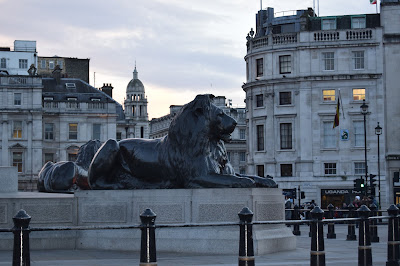Whilst being in London, and viewing the exhibitions, I also photographed my surroundings, I decided to include these in a photo documentary about 'London.' I wanted to capture London through the eyes of tourists, and commuters.
Below are my images which make up my 'Stereotypical London' Photo Documentary:
This is an iconic figure of London (the telephone bow), however what makes this image special is that the colour of the bow is black, not red, therefore this image is significant.
The red postbox is an iconic figure in London life, many tourists associate these with London, I wanted to capture the bright red colour, in order to make it almost 'pop' out of the photograph.
This image would be a usual sight for a commuter to work. The old lights and tall buildings would be seen daily by them.
This image creates the sense of chaos, therefore it shows an essential part of London- the business.
Street art is frequently seen in Trafalgar Square, therefore I had to include this in my series, many tourists will visit London to see the various street acts in Trafalgar square.
The national art gallery is an iconic building centred in Trafalgar square. May tourists will visit here, consequently this is why I included this image in my series.
This man is a street performer in Trafalgar square, you can frequently see all types of acts here. Many tourists visit Trafalgar square and see these attractions, subsequently I included this in my series of images.
The lions in Trafalgar square are known world wide, therefore many tourists would have viewed these and want to visit them if they ever came to London, therefore I included this image in my series.
This is a waterfall in Trafalgar square, with a statue beautifully placed inside. You can frequently see statues like this around London, therefore they're an essential part of London life.
This image shows how London is home to many buildings of an older style. I like how I also captured the red bus, and the iconic lion in the image. Personally, I believe this image shows London life off effectively.
Red buses are a well known iconic landmark of London, therefore I had to include these in my series.
This image is of the National Art Gallery at night, I decided to include this as it gives a perspective of what London is like at night.
This image again highlights what London is like at night, also you can see in the background the London Eye which is a vital landmark in London, along with the London underground sign.
This image shows what it's like waiting for a train at the London underground, may commuters would like this reality daily, therefore I felt it was important to include this photograph.
I photographed during the day, and night to reflect the different aspects of London life, when photographing at night I was following in the style of Luxemburg (an artist I had previously researched), as they're photographs of urban landscapes. Moreover, some of these images are photographed at night, similarly to Luxemburg.
Below are some contact sheets, which show all the images I photographed on the day:

































